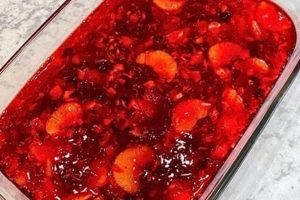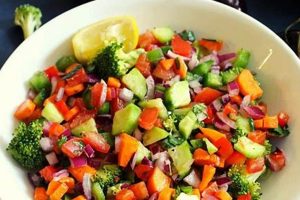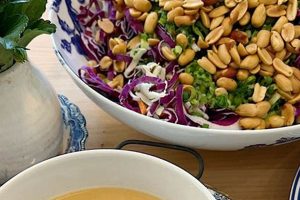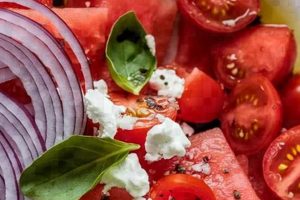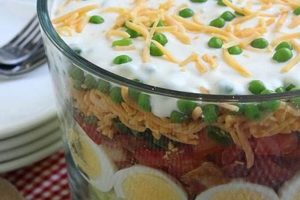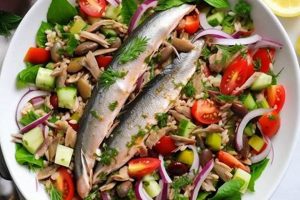Recipes for pea salad frequently utilize frozen peas as a key ingredient. This offers convenience and ensures a consistent product year-round, as fresh peas are often seasonally limited. Frozen peas maintain their sweetness and vibrant green color even after thawing, making them an ideal choice for this popular side dish. A basic preparation involves combining thawed peas with mayonnaise, onion, and celery, though numerous variations exist incorporating ingredients such as bacon, cheese, or different herbs.
The availability of frozen peas has significantly broadened the accessibility of pea salad, allowing it to be enjoyed beyond the short window of fresh pea season. This preservation method locks in nutrients and flavor, providing a healthy and delicious addition to meals throughout the year. Historically, pea salads were tied to spring harvests, but frozen peas have liberated the dish from seasonal constraints, making it a staple at picnics, potlucks, and everyday dining occasions. This readily available ingredient contributes to the enduring popularity of this versatile and refreshing salad.
The following sections will delve into various aspects of preparing pea salad with frozen peas, including specific recipes, tips for optimal results, and creative variations to enhance flavor and presentation.
Tips for Pea Salad Using Frozen Peas
Optimizing pea salad preparation involves careful consideration of ingredient selection and handling. The following tips offer guidance for achieving superior results.
Tip 1: Thorough Thawing and Drying: Complete thawing prevents ice crystals from diluting the salad’s flavor and creating a watery consistency. After thawing, peas should be thoroughly dried to prevent excess moisture from affecting the dressing’s emulsion.
Tip 2: Gentle Handling: Frozen peas can be delicate after thawing. Gentle handling, including careful mixing, prevents them from becoming mushy and maintains their appealing texture.
Tip 3: Flavor Balancing: The sweetness of peas necessitates a balanced dressing. Acidity, such as vinegar or lemon juice, complements the peas’ natural sweetness. The addition of sharp flavors like onion or red onion enhances the overall flavor profile.
Tip 4: Enhancing Texture: Incorporating ingredients like chopped celery, water chestnuts, or chopped bell peppers provides textural contrast and visual interest.
Tip 5: Dressing Considerations: Mayonnaise-based dressings are traditional, but variations using vinaigrette, yogurt, or sour cream offer lighter alternatives. Dressings should be added just before serving to prevent the salad from becoming soggy.
Tip 6: Chilling Time: Allowing the salad to chill for at least 30 minutes after preparation enhances flavor development and allows the ingredients to meld. Avoid excessive chilling, which can dull the flavors.
Tip 7: Fresh Herb Incorporation: Fresh herbs like dill, mint, or parsley elevate the salad’s flavor profile and add a touch of freshness. These should be added just before serving to maximize their impact.
By following these guidelines, one can consistently create a flavorful and visually appealing pea salad with frozen peas. Attention to detail ensures a delightful culinary experience.
The insights provided throughout this article aim to equip readers with the knowledge to confidently prepare pea salad using frozen peas. Experimentation with different ingredients and flavors is encouraged to discover personalized variations.
1. Frozen Peas
Frozen peas represent a crucial element within the context of pea salad recipes. Their availability transcends seasonality, enabling consistent preparation throughout the year. This contrasts sharply with fresh peas, whose availability is often limited to specific growing seasons. The impact of frozen peas on pea salad recipes is substantial, transforming what was once a seasonal dish into a year-round staple. This availability contributes significantly to the enduring popularity of pea salad. The freezing process preserves the peas’ sweetness and bright green color, factors highly desirable in a visually appealing and palatable salad. For instance, classic holiday meals often feature pea salad, a testament to its adaptability and the role frozen peas play in making it consistently achievable.
Furthermore, the ease of use afforded by frozen peas simplifies pea salad preparation. No shelling is required, reducing preparation time and effort. This convenience factor broadens the appeal of pea salad, making it an attractive option for busy individuals or those seeking quick and easy meal accompaniments. The uniform size and quality of frozen peas also contribute to a consistent final product, ensuring predictable results across multiple preparations. This reliability enhances the overall culinary experience, eliminating the variability often encountered with fresh produce.
In summary, frozen peas have revolutionized the accessibility and preparation of pea salad. Their consistent availability, ease of use, and preserved quality have solidified their place as the preferred ingredient in countless pea salad recipes. This understanding allows for efficient meal planning and consistent culinary outcomes, highlighting the practical significance of frozen peas within this specific culinary application. While challenges such as potential texture changes due to improper thawing exist, the overall benefits of using frozen peas in pea salad recipes significantly outweigh these minor drawbacks. This knowledge empowers individuals to confidently create a consistently delicious and visually appealing pea salad regardless of the season.
2. Thawing Technique
Thawing technique plays a pivotal role in the final quality of pea salad prepared with frozen peas. Improper thawing can negatively impact texture and flavor, resulting in a suboptimal dish. Understanding the nuances of various thawing methods ensures the peas retain their desirable characteristics, contributing to a successful pea salad.
- Cold Water Thawing
Submerging the frozen peas in a sealed bag in cold water is a rapid and effective thawing method. This approach minimizes cellular damage, preserving the peas’ texture and preventing them from becoming mushy. The cold temperature inhibits bacterial growth, maintaining food safety. Regular water changes ensure consistent thawing. This method is generally preferred for pea salad as it maintains the peas’ integrity, crucial for a pleasant textural experience within the salad.
- Refrigerator Thawing
Thawing frozen peas overnight in the refrigerator is a slower but equally effective method. This gentle thawing process minimizes the risk of mushiness, preserving the peas’ delicate structure. While convenient for meal prepping, this method requires advanced planning. Refrigerator thawing ensures the peas remain chilled, minimizing the risk of bacterial growth. This method is suitable for pea salad when time allows for advanced preparation.
- Microwave Thawing
Microwave thawing offers speed but requires careful attention to prevent uneven heating and partial cooking. Short bursts of low power, with frequent stirring, help ensure even thawing. Over-microwaving can result in mushy peas, undesirable in a pea salad. While convenient for quick preparation, this method requires careful monitoring to prevent compromised texture. This method is generally less preferred for pea salad due to the increased risk of textural degradation.
- Direct Incorporation (Not Recommended)
Adding frozen peas directly to the salad is discouraged. Uneven thawing creates an undesirable temperature gradient within the salad, potentially impacting food safety. Melting ice crystals dilute the dressing, affecting the overall flavor and texture. This approach compromises the sensory experience of the salad and may lead to an unevenly chilled final product.
The chosen thawing technique directly influences the texture, flavor, and overall quality of the pea salad. Selecting the appropriate method, such as cold water or refrigerator thawing, ensures the frozen peas contribute positively to the final dish, enhancing both the visual appeal and the sensory experience. Understanding these nuances allows for a more informed approach to pea salad preparation, maximizing the potential of this versatile ingredient.
3. Complementary Ingredients
Complementary ingredients are essential for a well-balanced and flavorful pea salad using frozen peas. These additions enhance the peas’ natural sweetness while adding textural complexity and visual appeal. Careful selection of complementary ingredients elevates the dish beyond a simple combination of peas and dressing, transforming it into a multi-dimensional culinary experience.
- Aromatics
Aromatics like onions, shallots, or chives provide a pungent counterpoint to the sweetness of peas. Red onion adds a sharp bite and vibrant color, while shallots offer a milder, more nuanced flavor. Chives contribute a delicate onion flavor and visual appeal. These aromatic additions create a more complex flavor profile, preventing the salad from tasting overly sweet or one-dimensional. For example, finely diced red onion provides both visual contrast and a sharp flavor that cuts through the richness of a mayonnaise-based dressing.
- Crunchy Vegetables
Adding crunchy vegetables provides textural contrast to the relatively soft texture of peas. Celery, diced bell peppers, or water chestnuts offer satisfying crispness, enhancing the overall sensory experience. These additions prevent the salad from becoming texturally monotonous. Diced celery is a classic addition, offering a refreshing crunch and slightly herbaceous flavor that complements the peas. Water chestnuts introduce a unique, subtly sweet crunch.
- Savory Elements
Incorporating savory elements like crumbled bacon, diced ham, or shredded cheddar cheese provides a salty, umami counterpoint to the peas’ sweetness. These ingredients add depth of flavor and richness. Crumbled bacon adds a smoky, savory flavor and satisfying crispness, while shredded cheddar cheese contributes a creamy texture and sharp, salty taste. These additions make the salad more substantial and satisfying.
- Fresh Herbs
Fresh herbs contribute a bright, fresh element to pea salad. Dill, mint, parsley, or chives enhance the overall flavor profile and add visual appeal. Dill offers a slightly tangy, herbaceous note, while mint provides a refreshing coolness. Parsley contributes a clean, slightly peppery flavor. These herbaceous additions elevate the salad beyond a simple combination of ingredients, creating a more complex and nuanced flavor profile.
The strategic incorporation of complementary ingredients elevates pea salad with frozen peas from a basic side dish to a more complex and satisfying culinary creation. Balancing the peas’ sweetness with aromatics, adding textural contrast with crunchy vegetables, incorporating savory elements, and including fresh herbs contributes to a well-rounded flavor profile and a more enjoyable dining experience. Consideration of these elements allows for customization and personalization, ensuring the final dish aligns with individual preferences and dietary considerations.
4. Dressing Choice
Dressing choice significantly impacts the overall flavor profile and success of a pea salad utilizing frozen peas. The dressing serves to bind the ingredients, contributing moisture and flavor while balancing the inherent sweetness of the peas. A thoughtfully chosen dressing elevates the salad from a simple combination of components to a cohesive and flavorful dish. Failing to consider the dressing’s impact can result in a bland or unbalanced salad, undermining the quality of the frozen peas and other ingredients.
Classic mayonnaise-based dressings offer a creamy texture and tangy flavor that complements the sweetness of peas. Variations incorporating sour cream or yogurt provide a lighter alternative while retaining creaminess. For a brighter, more acidic profile, vinaigrette dressings, often incorporating lemon juice or vinegar, provide a refreshing counterpoint. A lemon-dill vinaigrette, for example, enhances the peas’ sweetness while adding a vibrant, herbaceous note. Alternatively, a creamy dressing infused with bacon and blue cheese offers a richer, more savory dimension. The chosen dressing should harmonize with the other ingredients, creating a balanced and cohesive flavor experience.
The practical significance of dressing choice lies in its ability to transform the character of the pea salad. A heavy mayonnaise-based dressing creates a richer, more traditional salad, while a light vinaigrette yields a fresher, more contemporary interpretation. Understanding the interplay between dressing and other ingredients empowers informed decision-making, enabling customization based on desired flavor profiles and dietary considerations. Successfully navigating dressing choices ensures the frozen peas and complementary ingredients contribute harmoniously to a well-balanced and enjoyable pea salad, maximizing the potential of this versatile dish. Overly sweet or excessively tart dressings can overwhelm the delicate flavor of the peas, highlighting the importance of balanced flavor profiles. The dressing also influences the salad’s overall texture and mouthfeel, contributing to the final sensory experience.
5. Texture Variations
Texture variations play a crucial role in elevating pea salad featuring frozen peas beyond a simple, homogenous dish. Introducing contrasting textures creates a more dynamic and engaging sensory experience, preventing the salad from feeling monotonous. The interplay of textures adds complexity and interest, making each bite more satisfying. Understanding how different ingredients contribute textural nuances allows for a more thoughtful and deliberate approach to pea salad preparation.
- Crunchy Elements
Crunchy elements provide a stark contrast to the tender peas, creating a dynamic textural interplay. Common examples include chopped celery, water chestnuts, or chopped bell peppers. These ingredients introduce a satisfying snap or crunch, enhancing the overall mouthfeel. In a pea salad, the inclusion of crunchy elements prevents the dish from becoming overly soft or mushy, contributing to a more enjoyable and balanced sensory experience. Toasted nuts, such as slivered almonds or chopped pecans, can also contribute a desirable crunch and nutty flavor.
- Creamy Components
Creamy components, primarily introduced through the dressing, contribute richness and bind the salad together. Traditional mayonnaise-based dressings provide a smooth, creamy texture that coats the other ingredients. Variations incorporating sour cream or yogurt offer similar creaminess with a slightly tangier flavor profile. This creaminess contrasts with the crunchier elements and the tender peas, creating a multi-layered textural experience. The choice of creamy component influences the overall richness and mouthfeel of the salad.
- Protein-Based Textures
Incorporating protein not only adds nutritional value but also introduces textural variety. Crumbled bacon or diced ham offer a chewy, savory contrast to the other ingredients. Hard cheeses, such as cheddar or cubed Swiss, introduce a firm texture and a salty, sharp flavor. These protein-based additions enhance the overall complexity of the salad, making it more substantial and satisfying. The choice of protein influences the flavor profile as well as the textural dynamic.
- Pea Texture Preservation
Maintaining the peas’ natural texture is paramount. Proper thawing techniques, as discussed previously, prevent the peas from becoming mushy. Overcooking or excessive handling can compromise their texture, negatively impacting the overall quality of the salad. Preserving the peas’ slight firmness contributes to a more pleasant and balanced textural experience within the salad. Their texture acts as a foundation against which the other textural elements play.
The thoughtful integration of various textures transforms pea salad with frozen peas into a more dynamic and satisfying culinary experience. The interplay of crunchy, creamy, chewy, and tender elements adds depth and complexity, ensuring that each bite offers a diverse range of sensations. Successfully managing these textural variations elevates the dish beyond a simple side and allows for greater culinary creativity, catering to a wider range of palates and preferences.
6. Chilling Duration
Chilling duration significantly influences the final quality and flavor profile of pea salad prepared with frozen peas. Adequate chilling allows flavors to meld and develop, resulting in a more cohesive and balanced final product. Conversely, insufficient chilling or excessive chilling can negatively impact the salad’s overall appeal, affecting both taste and texture. Understanding the role of chilling duration is crucial for optimizing pea salad preparation and achieving desired culinary outcomes.
- Flavor Development
Chilling allows the flavors of the various ingredients, including the peas, dressing, and aromatics, to meld and harmonize. This integration of flavors creates a more complex and nuanced taste profile compared to a freshly mixed salad. The chemical reactions responsible for flavor development often occur more slowly at lower temperatures, necessitating a period of chilling for optimal flavor integration. A minimum chilling time of 30 minutes is generally recommended, although longer durations can further enhance flavor development, particularly for salads with complex dressings or a wider variety of ingredients.
- Temperature and Food Safety
Chilling ensures the salad remains at a safe temperature, inhibiting bacterial growth and maintaining food safety. This is particularly crucial for salads containing mayonnaise-based dressings, which are more susceptible to bacterial contamination at warmer temperatures. Maintaining a consistently chilled temperature throughout the preparation and serving process is essential for preventing foodborne illnesses. Proper chilling also enhances the refreshing quality of the salad, making it more enjoyable to consume, especially in warmer weather.
- Texture Enhancement
Chilling can positively influence the texture of certain ingredients in the salad. Crunchy vegetables, like celery and water chestnuts, retain their crispness more effectively when chilled. The cold temperature also firms the thawed peas, preventing them from becoming mushy. This preservation of texture contributes to a more appealing and satisfying sensory experience. However, excessive chilling can negatively impact the texture of some ingredients, making them overly firm or tough. Finding the optimal chilling duration ensures a balanced textural profile within the salad.
- Over-Chilling Considerations
While chilling is beneficial, excessive chilling can have detrimental effects. Overly chilled salads can dull flavors and make certain ingredients, such as fresh herbs, lose their vibrancy. The delicate flavors of fresh herbs are best preserved when added just before serving, after the chilling period. Over-chilling can also make mayonnaise-based dressings become overly thick or separate, negatively impacting the salad’s overall texture and appearance. Balancing chilling time with these considerations ensures optimal flavor and texture preservation.
Optimizing chilling duration is essential for maximizing the quality and enjoyment of pea salad made with frozen peas. Balancing flavor development, food safety, and textural considerations ensures a harmonious blend of flavors and textures. Careful attention to chilling time elevates the dish, showcasing the potential of frozen peas and complementary ingredients while ensuring a safe and satisfying culinary experience. Understanding these nuances allows for informed decision-making and customization, catering to individual preferences and maximizing the enjoyment of this classic dish.
Frequently Asked Questions
This section addresses common inquiries regarding the preparation and enjoyment of pea salad using frozen peas. Clarification on these points aims to facilitate successful culinary outcomes and enhance understanding of this versatile dish.
Question 1: Can frozen peas be used directly from the freezer in pea salad?
Direct incorporation of frozen peas is not recommended. Uneven thawing creates temperature inconsistencies within the salad, potentially compromising food safety. Melting ice crystals dilute the dressing, negatively affecting flavor and texture. Proper thawing techniques are essential for optimal results.
Question 2: How can mushy peas be avoided in pea salad?
Mushy peas result from improper thawing or overcooking. Recommended thawing methods, such as cold water or refrigerator thawing, minimize cellular damage. Gentle handling during preparation and avoiding excessive chilling further contribute to optimal pea texture.
Question 3: What dressings are suitable for pea salad with frozen peas?
Mayonnaise-based dressings are traditional, offering a creamy texture and tangy flavor. Lighter alternatives include vinaigrette dressings, yogurt-based dressings, or those incorporating sour cream. Dressing choice should complement the other ingredients and desired flavor profile.
Question 4: How long should pea salad with frozen peas be chilled?
A minimum chilling time of 30 minutes allows flavors to meld. Longer chilling enhances flavor development but should avoid extremes that can dull flavors or negatively affect textures. Optimal chilling duration depends on specific ingredients and desired outcome.
Question 5: How can one enhance the flavor of pea salad made with frozen peas?
Flavor enhancement can be achieved through the incorporation of aromatics like onions or chives, crunchy vegetables such as celery or water chestnuts, savory elements like bacon or cheese, and fresh herbs such as dill or mint. Balancing these additions creates a more complex and satisfying flavor profile.
Question 6: How long does pea salad with frozen peas remain fresh?
Properly stored in an airtight container in the refrigerator, pea salad typically remains fresh for 3-5 days. Factors influencing shelf life include ingredient freshness and storage temperature. Discarding the salad when any signs of spoilage appear is crucial for food safety.
Addressing these frequently asked questions provides a deeper understanding of pea salad preparation using frozen peas. Consideration of these points facilitates consistent and successful culinary outcomes, maximizing the potential of this versatile dish.
Further exploration of recipe variations and serving suggestions can enhance culinary creativity and personalize the pea salad experience. Experimentation with different ingredients and flavor combinations allows for customization and discovery of preferred flavor profiles.
Pea Salad Recipe
Pea salad recipes utilizing frozen peas offer a convenient and versatile approach to this classic dish. Exploration of ingredient selection, thawing techniques, complementary components, dressing choices, texture variations, and chilling duration reveals the multifaceted nature of successful pea salad preparation. Frozen peas provide consistent availability and quality, enabling enjoyment of this dish year-round. Careful consideration of complementary ingredients, such as aromatics, crunchy vegetables, savory elements, and fresh herbs, enhances flavor complexity and textural appeal. Proper thawing and chilling techniques preserve the peas’ desirable texture and contribute to food safety. Thoughtful dressing selection balances the peas’ inherent sweetness and harmonizes with other ingredients. Attention to these elements ensures a consistently satisfying culinary outcome.
Pea salad’s adaptability and ease of preparation, facilitated by the use of frozen peas, position it as a relevant culinary choice across diverse settings, from casual gatherings to more formal occasions. Continued exploration of flavor combinations and creative presentation offers potential for personalized variations and ongoing culinary discovery. Understanding the fundamental principles outlined herein empowers culinary enthusiasts of all skill levels to confidently create delicious and visually appealing pea salads with frozen peas, contributing to the enduring legacy of this versatile dish.

